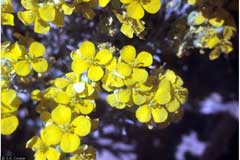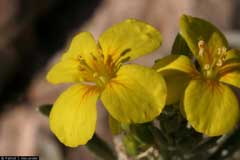 |
|
G.A. Cooper @ USDA-NRCS PLANTS Database |
 |
| Patrick J. Alexander @ USDA-NRCS PLANTS Database |
Translate this page:
Summary
Physical Characteristics

 Lesquerella fendleri is a PERENNIAL growing to 0.4 m (1ft 4in). The species is hermaphrodite (has both male and female organs).
Lesquerella fendleri is a PERENNIAL growing to 0.4 m (1ft 4in). The species is hermaphrodite (has both male and female organs).
Suitable for: light (sandy), medium (loamy) and heavy (clay) soils. Suitable pH: mildly acid, neutral and basic (mildly alkaline) soils. It can grow in semi-shade (light woodland) or no shade. It prefers moist soil.
UK Hardiness Map
US Hardiness Map
Synonyms
Plant Habitats
Cultivated Beds;
Edible Uses
References More on Edible Uses
Medicinal Uses
Plants For A Future can not take any responsibility for any adverse effects from the use of plants. Always seek advice from a professional before using a plant medicinally.
None known
References More on Medicinal Uses
The Bookshop: Edible Plant Books
Our Latest books on Perennial Plants For Food Forests and Permaculture Gardens in paperback or digital formats.

Edible Tropical Plants
Food Forest Plants for Hotter Conditions: 250+ Plants For Tropical Food Forests & Permaculture Gardens.
More

Edible Temperate Plants
Plants for Your Food Forest: 500 Plants for Temperate Food Forests & Permaculture Gardens.
More

More Books
PFAF have eight books available in paperback and digital formats. Browse the shop for more information.
Shop Now
Other Uses
The seed yields up to 28% oil and 22% protein[269]. Average yields of 1.1 tonnes per hectare have been postulated and in small-scale experiments 1.6 tonnes has been attained[269]. The oil has possibilities in the manufacture of grease thickeners due to the hydroxy-acid content. Major amounts of hydroxy-acids occur in the obscure seed oils, among them Lesquerella, but few of them have been subjected to development. According to Osman and Ahmad (1981), the only hydroxylated vegetable oil commercially available is castor oil. Other potential sources include Castalis, Coriaria, Dimorphotheca, Hiptage, and Osteospermum[269].
Special Uses
References More on Other Uses
Cultivation details
Bladderpod is reported to tolerate an annual precipitation of 30 to 110cm, an annual temperature range of 13 to 15°C and a pH in the range of 5.6 to 8.3[269]. The seeds germinate in the autumn, flower in the spring, and seed is harvested in late spring. This is indicative of its requirements for cool, semi-arid conditions during growth. The plant thrives in areas with 25 - 40 cm rainfall from September through April, suggestive of the requirements of winter grains. The plant responds well to irrigation. In Texas, massive populations thrive on calich soil. The plant is a pioneer on disturbed soils which are dry, open, well-drained sites. It will tolerate soils with basic reaction (pH 8.2 - 8.3) but not those with salt or gypsum. The plant is reported to tolerate frost and high pH[269]. Bladder-pod is cultivated for the seed which yields up to 28% oil and 22% protein[269]. A relatively new crop, bladder-pod has no recognized cvs. Because it is very polymorphic, "certainly the most polymorphic in the genus", it offers genetic material for selection and breeding[269]. In its native range, the plant is cold tolerant at altitudes of 1,200 - 2,100 m, suggesting its use for more northern cultivation. At seed maturation or failing moisture, the plant dries and the taproot breaks off, allowing the dried plant to blow about like tumbleweeds, thus dispersing the seeds[269].
References Carbon Farming Information and Carbon Sequestration Information
Temperature Converter
Type a value in the Celsius field to convert the value to Fahrenheit:
Fahrenheit:
The PFAF Bookshop
Plants For A Future have a number of books available in paperback and digital form. Book titles include Edible Plants, Edible Perennials, Edible Trees,Edible Shrubs, Woodland Gardening, and Temperate Food Forest Plants. Our new book is Food Forest Plants For Hotter Conditions (Tropical and Sub-Tropical).
Shop Now
Plant Propagation
Seed - we have no information for Britain, but in its native range the plant germinates in the autumn. Thus direct sowings in situ could be tried both in the autumn and in the spring in Britain[K]. Seeds can germinate after being dormant up to 5 years[269]. Under normal situations, light is required for germination[269]. Optimum germination temperature is 20°C[269].
Other Names
If available other names are mentioned here
Native Range
NORTHERN AMERICA: United States (Kansas, Oklahoma, Colorado, New Mexico, Texas, Arizona (southeast), Utah (southeast)), Mexico (Chihuahua, Coahuila de Zaragoza, Durango, Nuevo León, San Luis Potosí, Zacatecas)
Weed Potential
Right plant wrong place. We are currently updating this section.
Please note that a plant may be invasive in one area but may not in your area so it's worth checking.
Conservation Status
IUCN Red List of Threatened Plants Status :

Growth: S = slow M = medium F = fast. Soil: L = light (sandy) M = medium H = heavy (clay). pH: A = acid N = neutral B = basic (alkaline). Shade: F = full shade S = semi-shade N = no shade. Moisture: D = dry M = Moist We = wet Wa = water.
Now available:
Food Forest Plants for Mediterranean Conditions
350+ Perennial Plants For Mediterranean and Drier Food Forests and Permaculture Gardens.
[Paperback and eBook]
This is the third in Plants For A Future's series of plant guides for food forests tailored to
specific climate zones. Following volumes on temperate and tropical ecosystems, this book focuses
on species suited to Mediterranean conditions—regions with hot, dry summers and cool, wet winters,
often facing the added challenge of climate change.
Read More
Expert comment
Author
(A.Gray.)S.Wats.
Botanical References
274
Links / References
For a list of references used on this page please go here
Readers comment
| Add a comment |
|
If you have important information about this plant that may help other users please add a comment or link below. Only comments or links that are felt to be directly relevant to a plant will be included. If you think a comment/link or information contained on this page is inaccurate or misleading we would welcome your feedback at [email protected]. If you have questions about a plant please use the Forum on this website as we do not have the resources to answer questions ourselves.
* Please note: the comments by website users are not necessarily those held by PFAF and may give misleading or inaccurate information.
To leave a comment please Register or login here All comments need to be approved so will not appear immediately.
|
Subject : Lesquerella fendleri
|
|
|
|